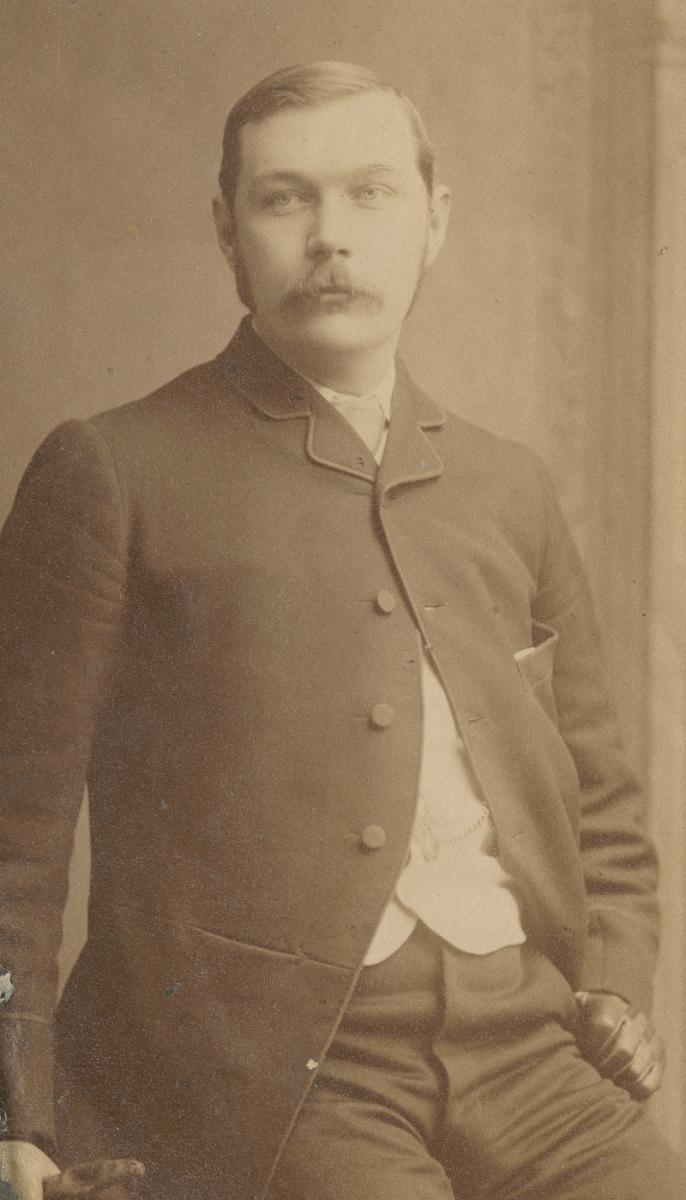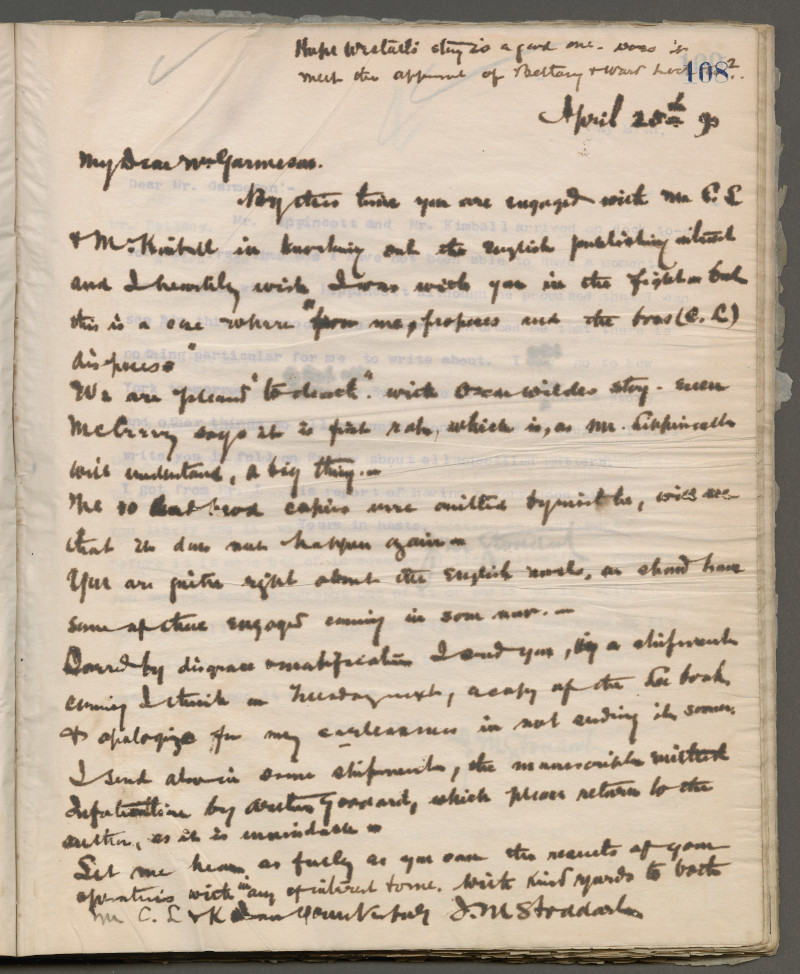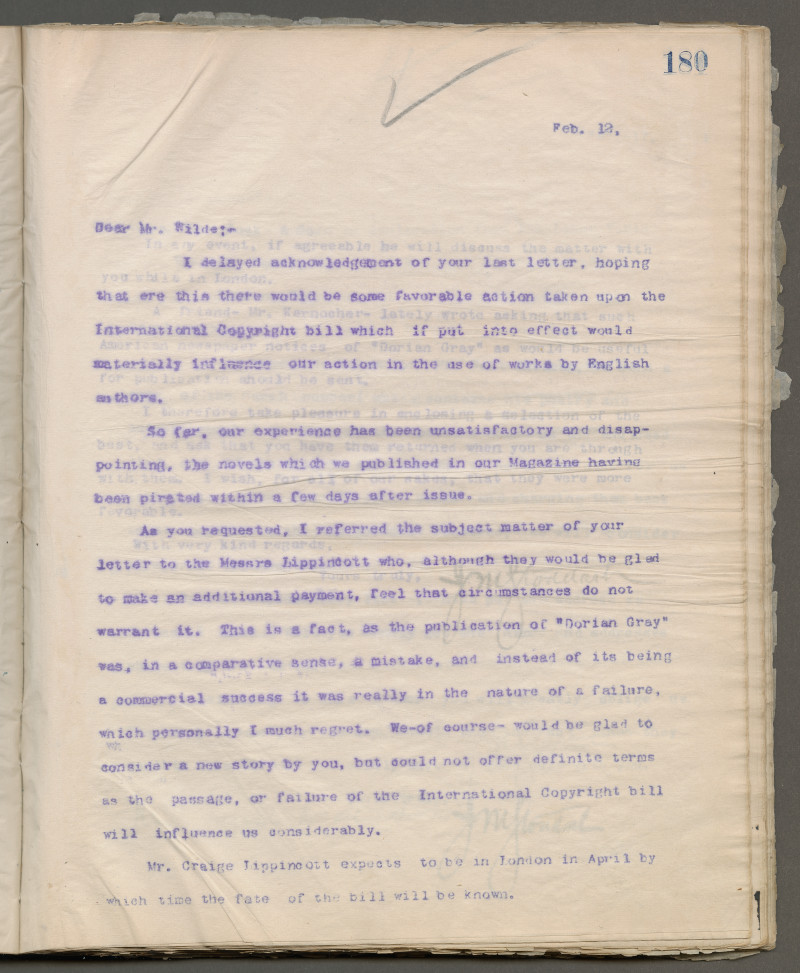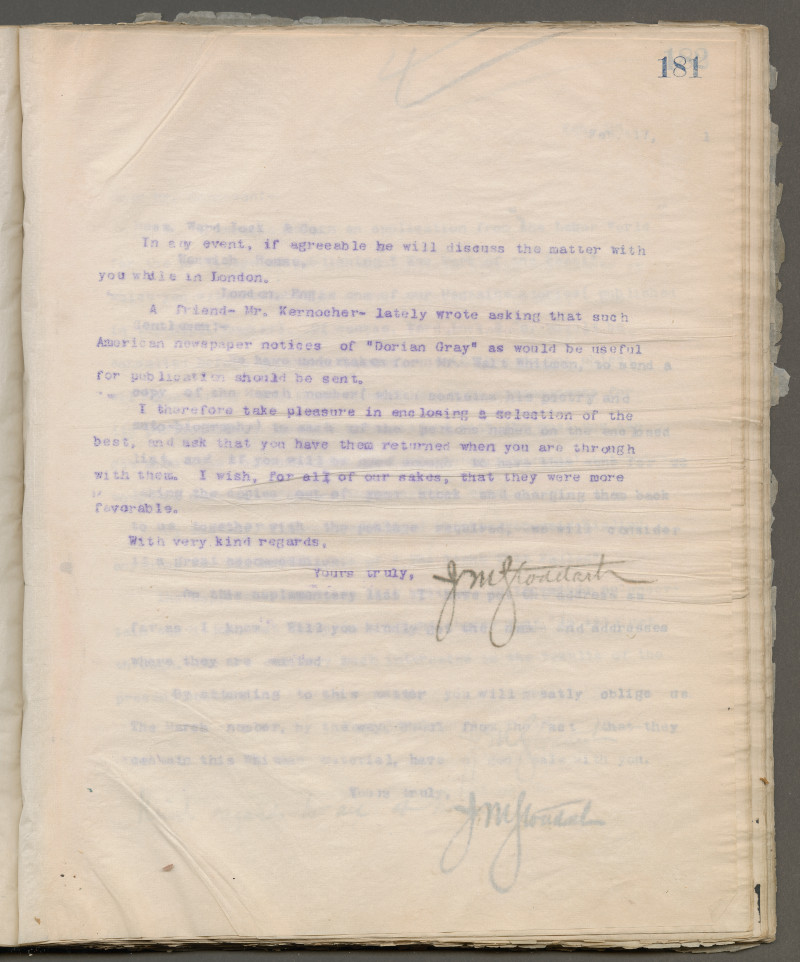This blog post was written by Sara Nash, processor of the J. B. Lippincott Company records (Collection 3104).

Oscar Wilde, photograph (undated), Philadelphia Record photograph morgue collection (V07), Historical Society of Pennsylvania.
Scholars and literary fans of Sir Arthur Conan Doyle and Oscar Wilde likely already know that their beloved stories first appeared in Lippincott’s Monthly Magazine. Many may not know of the connection between the two authors and the stories which were published in 1890. The J. B. Lippincott Company records (Collection 3104) contain correspondence that illuminates the backstory.
In late July 1889, Joseph Marshall Stoddart, general manager and editor of Lippincott’s Monthly Magazine, sailed for England. He hoped to secure stories from prominent English authors who would be well received by American readers. The English edition of the magazine was set to launch in January 1890. Publication in both countries would be simultaneous. Lippincott would print and ship the bulk of the issue to Ward Lock & Co., who would bind it with material suited to the market. Stoddart felt that success of the venture depended upon having excellent English stories to draw sales in England.
While in London, Stoddart arranged a dinner at the Langham Hotel with Doyle, Wilde, and an Irish M.P. (Member of Parliament), Thomas Gill. Doyle called the occasion a “golden evening” in his autobiography, describing Wilde as charming and engaging. By the end of the evening, both men had promised stories to Stoddart for the magazine. Stoddart wrote to Doyle upon his return to Philadelphia, “I left London in such a hurry that I was unable to acknowledge your favor of Sept. 3rd, which was in acceptance of our proposition of Aug. 30th... I like the title ‘The Sign of the Six,’ very well indeed… If you succeed in keeping up the interest in Sherlock Holmes, you are sure to have a good book.”i While the occasion was an obvious success for all concerned, these were the only English authors Stoddart was able to secure for Lippincott’s on the trip.

Sir Arthur Conan Doyle, photograph (undated), HSP portrait collection (Collection V88), Historical Society of Pennsylvania.
Alas, the results were not quite what Stoddart and his employer had hoped. Doyle’s story was received and approved in late October, but they judged it too weak to anchor the first English edition. Instead the piece, with a new title at the suggestion of Doyle, “The Sign of the Four” appeared in the February number. Despite their reservations, the story was well received, and the house then reprinted “A Study in Scarlet.”
In contrast, Oscar Wilde’s story was repeatedly delayed. Stoddart suspected from the beginning that the story would be late, and his September 17, 1899, letter to Joseph Garmeson, head of Lippincott’s London agency, reflected his anxiety. He stated, “I wish by the way, as there may be some delay with Oscar Wilde’s story, that you would be on the lookout for some English writer.”ii The next day, he wrote to Wilde to encourage submission by early October to make the inaugural edition of the magazine.iii Two days later, he instructed Garmeson to find another author to provide a story that would appeal to English readers if Wilde could not submit his in time.iv Wilde agreed to send the story by early November, though he indicated it would be short.v Instead of the manuscript, Stoddart received a letter stating that Wilde was ill and further was unsatisfied with the story. Stoddart was, in his own words, “bitterly disappointed.”vi
A partial manuscript did not reach Philadelphia until early April 1890, and while Stoddart and his colleagues considered it a strong story, there were issues. In a letter to Craige Lippincott, in London at the time, Stoddart writes, “In its present condition there are a number of things which an innocent woman would make an exception to but I will go beyond this and make it acceptable to the most fastidious taste.”vii In a later letter to Garmeson, he writes, “We are pleased ‘to death’ with Oscar Wilde’s story. Even [Joseph] McCreery says it is first rate, which is, as Mr. Lippincott will understand, a big thing.”viii

The full manuscript arrived in early June and was published in the July number. Stoddart wrote to Garmeson, “The Oscar Wilde story starts with great promise but as it has only been published several days I cannot tell much about it, I have an idea, however, it will approach “The Quick or the Dead” in sale.”ix
Unfortunately for the publisher, this hope remained unfulfilled. Reviews were critical and worse, the story was pirated and reprinted within days of publication. Lippincott had no legal recourse as copyright protection in America did not extend to works by foreign authors. In February 1891, Stoddart wrote to Wilde, “The publication of ‘Dorian Gray’ was, in a comparative sense, a mistake, and instead of its being a commercial success it was really in the nature of a failure, which personally I much regret.”x


In an earlier letter to Doyle, Stoddard had explained that the house would not publish any more works by English authors until the copyright matter was settled because stories were consistently being pirated, depriving the magazine of their benefit.xi The International Copyright Act would become law a few weeks later.
In 1891, probably neither Stoddart nor his employer would have called the evening of August 30, 1899, golden. Things look different over a century and a quarter later. Both stories are now considered classics and form a notable piece of the J. B. Lippincott Company legacy. Their authors continue to have devoted followings, and in 2010, a plaque was installed on the Langham hotel commemorating the dinner by the Sherlock Holmes Society of London and the Oscar Wilde Society.
i Boxed volume 7.5, p. 236, J.B. Lippincott Company records (Collection 3104), Historical Society of Pennsylvania.
ii Boxed volume 61.2 p. 230, J.B. Lippincott Company records (Collection 3104), Historical Society of Pennsylvania.
iii Boxed volume 7.5, p. 237, J.B. Lippincott Company records (Collection 3104), Historical Society of Pennsylvania.
iv Boxed volume 61.2, p. 264, J.B. Lippincott Company records (Collection 3104), Historical Society of Pennsylvania.
v Boxed volume 61.2 p. 393, J.B. Lippincott Company records (Collection 3104), Historical Society of Pennsylvania.
vi Boxed volume 61.2 p. 16, J.B. Lippincott Company records (Collection 3104), Historical Society of Pennsylvania.
vii Boxed volume 61.2, p. 102, J.B. Lippincott Company records (Collection 3104), Historical Society of Pennsylvania.
viii Boxed volume 61.2, p. 108, J.B. Lippincott Company records (Collection 3104), Historical Society of Pennsylvania.
ix Boxed volume 61.2 p. 123, J.B. Lippincott Company records (Collection 3104), Historical Society of Pennsylvania.
x Boxed volume 61.2, p. 180, J.B. Lippincott Company records (Collection 3104), Historical Society of Pennsylvania.
xi Boxed volume 61.2, p. 173, J.B. Lippincott Company records (Collection 3104), Historical Society of Pennsylvania.

